
Chapter 16 The d-block elements(I) Part I d-block elements:general considerations (1)"Zncomplexes are atypical of d-block complexes in general."Which answer below is correct and supports this statement? A)Zn2complexes are paramagnetic B)Zncomplexes tend to be colourless C)Zncomplexes are always octahedral D)Zn2is one of several common oxidation states ofZn (2)In the complex [Ni(NH3),the approximate charge distribution in accord with the electroneutrality principle is: A)Ni,+2,NH3,0 B)Ni,-4:NH3,+1 C)Ni,+l;NH3,+l/6 D)Ni,0,NH3,+1/3 (3)Which geometry is not consistent with a coordination number of 8? A)Dodecahedral B)Square antiprismatic C)Hexagonal pyramidal D)Bicapped trigonal prismatic (4)In the static,capped trigonal prismatic structure of the number of F environments is: A)7 B)5 C)3 D)2
Chapter 16 The d-block elements ( ) Ⅰ Part 1 d-block elements: general considerations (1) ''Zn2+ complexes are atypical of d-block complexes in general.'' Which answer below is correct and supports this statement? A) Zn2+ complexes are paramagnetic B) Zn2+ complexes tend to be colourless C) Zn2+ complexes are always octahedral D) Zn2+ is one of several common oxidation states of Zn (2) In the complex [Ni(NH3)6] 2+, the approximate charge distribution in accord with the electroneutrality principle is: A) Ni, +2; NH3, 0 B) Ni, –4; NH3, +1 C) Ni, +1; NH3, +1/6 D) Ni, 0; NH3, +1/3 (3) Which geometry is not consistent with a coordination number of 8? A) Dodecahedral B) Square antiprismatic C) Hexagonal pyramidal D) Bicapped trigonal prismatic (4) In the static, capped trigonal prismatic structure of [ZrF7] 3–, the number of F environments is: A) 7 B) 5 C) 3 D) 2 1
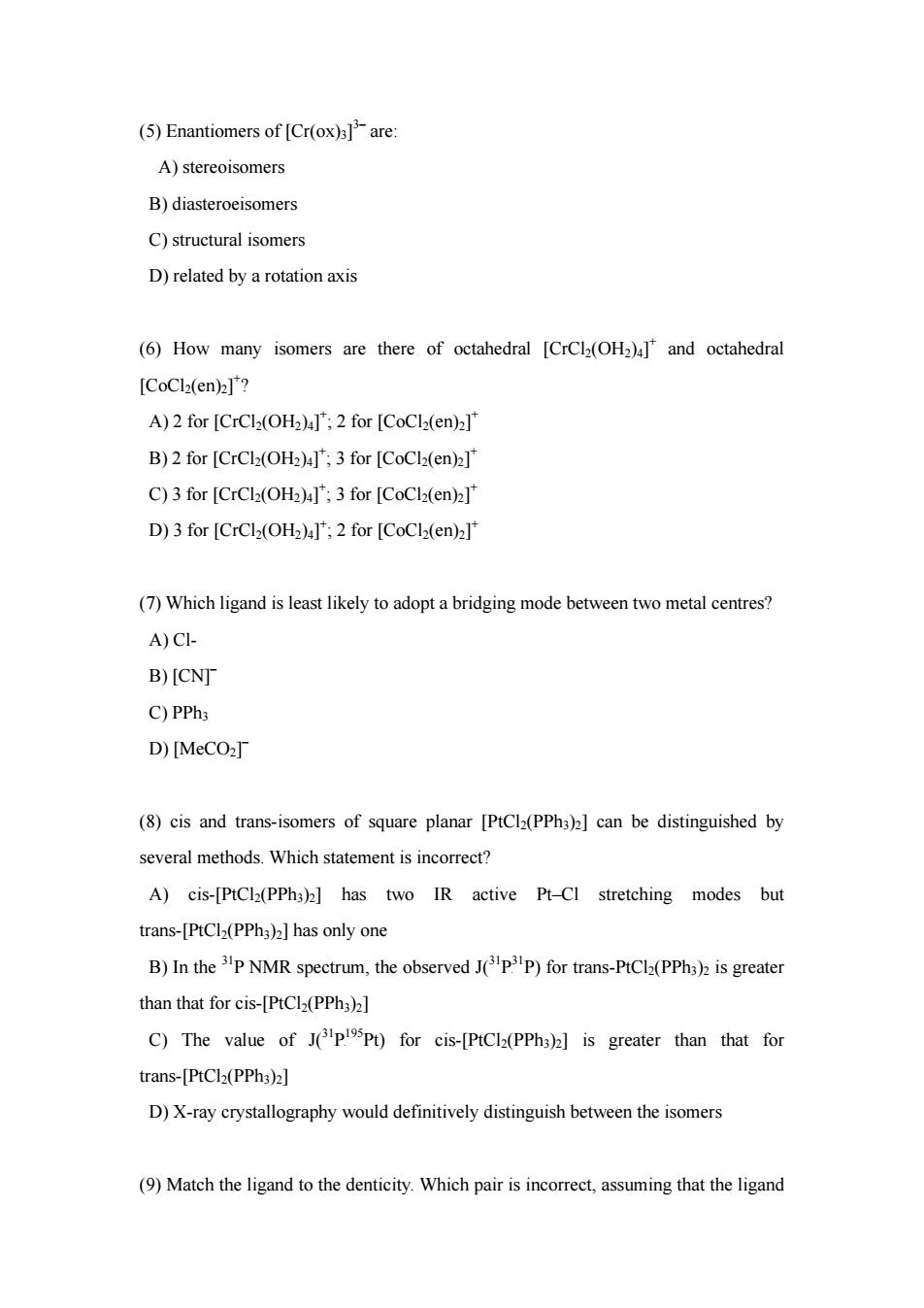
(5)Enantiomers of [Cr(ox)3]are: A)stereoisomers B)diasteroeisomers C)structural isomers D)related by a rotation axis (6)How many isomers are there of octahedral [CrCla(OH2)and octahedral [CoClz(en)2J*? A)2 for [CrCl2(OH2)2 for [CoCla(en)2] B)2 for [CrCla(OH2)4]";3 for [CoClz(en)2]" C)3 for [CrClz(OH2)4]3 for [CoClz(en)2]" D)3 for [CrClz(OH2)4 2 for [CoCl(en)2 (7)Which ligand is least likely to adopt a bridging mode between two metal centres? A)CI- B)[CNT C)PPhs D)[MeCO2 (8)cis and trans-isomers of square planar [PtCl2(PPh3)2]can be distinguished by several methods.Which statement is incorrect? A)cis-[PtCl2(PPh3)2]has two IR active Pt-CI stretching modes but trans-[PtCl(PPh3)2]has only one B)In the 3P NMR spectrum,the observed J(3P3P)for trans-PtCl2(PPh3)2 is greater than that for cis-[PtCl2(PPh3)2] C)The value of J(3P!Pt)for cis-[PtCla(PPh3)2]is greater than that for trans-[PtClz(PPh3)2] D)X-ray crystallography would definitively distinguish between the isomers (9)Match the ligand to the denticity.Which pair is incorrect,assuming that the ligand
(5) Enantiomers of [Cr(ox)3] 3– are: A) stereoisomers B) diasteroeisomers C) structural isomers D) related by a rotation axis (6) How many isomers are there of octahedral [CrCl2(OH2)4] + and octahedral [CoCl2(en)2] + ? A) 2 for [CrCl2(OH2)4] + ; 2 for [CoCl2(en)2] + B) 2 for [CrCl2(OH2)4] + ; 3 for [CoCl2(en)2] + C) 3 for [CrCl2(OH2)4] + ; 3 for [CoCl2(en)2] + D) 3 for [CrCl2(OH2)4] + ; 2 for [CoCl2(en)2] + (7) Which ligand is least likely to adopt a bridging mode between two metal centres? A) Cl- B) [CN]– C) PPh3 D) [MeCO2] – (8) cis and trans-isomers of square planar [PtCl2(PPh3)2] can be distinguished by several methods. Which statement is incorrect? A) cis-[PtCl2(PPh3)2] has two IR active Pt–Cl stretching modes but trans-[PtCl2(PPh3)2] has only one B) In the 31P NMR spectrum, the observed J(31PP 31P) for trans-PtCl (PPh ) is greater than that for cis-[PtCl (PPh ) ] 2 3 2 2 3 2 C) The value of J(31PP 195Pt) for cis-[PtCl (PPh ) ] is greater than that for trans-[PtCl (PPh ) ] 2 3 2 2 3 2 D) X-ray crystallography would definitively distinguish between the isomers (9) Match the ligand to the denticity. Which pair is incorrect, assuming that the ligand 2
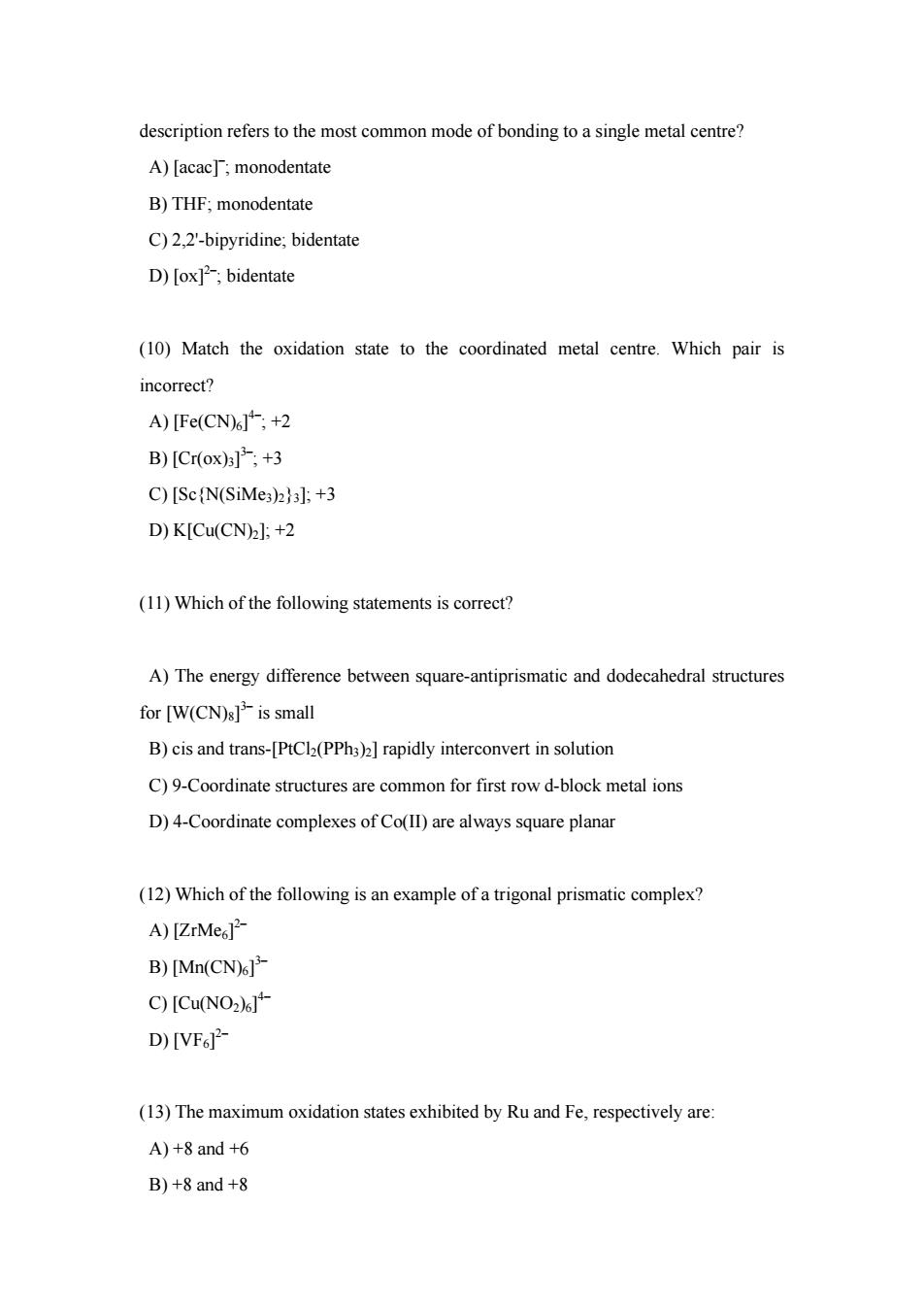
description refers to the most common mode of bonding to a single metal centre? A)[acac]monodentate B)THF;monodentate C)2.2-bipyridine;bidentate D)[ox]bidentate (10)Match the oxidation state to the coordinated metal centre.Which pair is incorrect? A)[Fe(CN)6];+2 B)[Cr(ox):]+3 C)[Sc(N(SiMe3))3]:+3 D)K[Cu(CN)z]:+2 (11)Which of the following statements is correct? A)The energy difference between square-antiprismatic and dodecahedral structures for[W(CN)sJ产is small B)cis and trans-[PtCl(PPh3)]rapidly interconvert in solutior C)9-Coordinate structures are common for first row d-block metal ions D)4-Coordinate complexes of Co(II)are always square planar (12)Which of the following is an example of a trigonal prismatic complex? A)[ZrMes]- B)[Mn(CN)6] C)[Cu(NO2)6J D)[VFsl- (13)The maximum oxidation states exhibited by Ru and Fe,respectively are: A)+8 and+6 B)+8 and+8
description refers to the most common mode of bonding to a single metal centre? A) [acac]– ; monodentate B) THF; monodentate C) 2,2'-bipyridine; bidentate D) [ox]2–; bidentate (10) Match the oxidation state to the coordinated metal centre. Which pair is incorrect? A) [Fe(CN)6] 4–; +2 B) [Cr(ox)3] 3–; +3 C) [Sc{N(SiMe3)2}3]; +3 D) K[Cu(CN)2]; +2 (11) Which of the following statements is correct? A) The energy difference between square-antiprismatic and dodecahedral structures for [W(CN)8] 3– is small B) cis and trans-[PtCl2(PPh3)2] rapidly interconvert in solution C) 9-Coordinate structures are common for first row d-block metal ions D) 4-Coordinate complexes of Co(II) are always square planar (12) Which of the following is an example of a trigonal prismatic complex? A) [ZrMe6] 2– B) [Mn(CN)6] 3– C) [Cu(NO2)6] 4– D) [VF6] 2– (13) The maximum oxidation states exhibited by Ru and Fe, respectively are: A) +8 and +6 B) +8 and +8 3
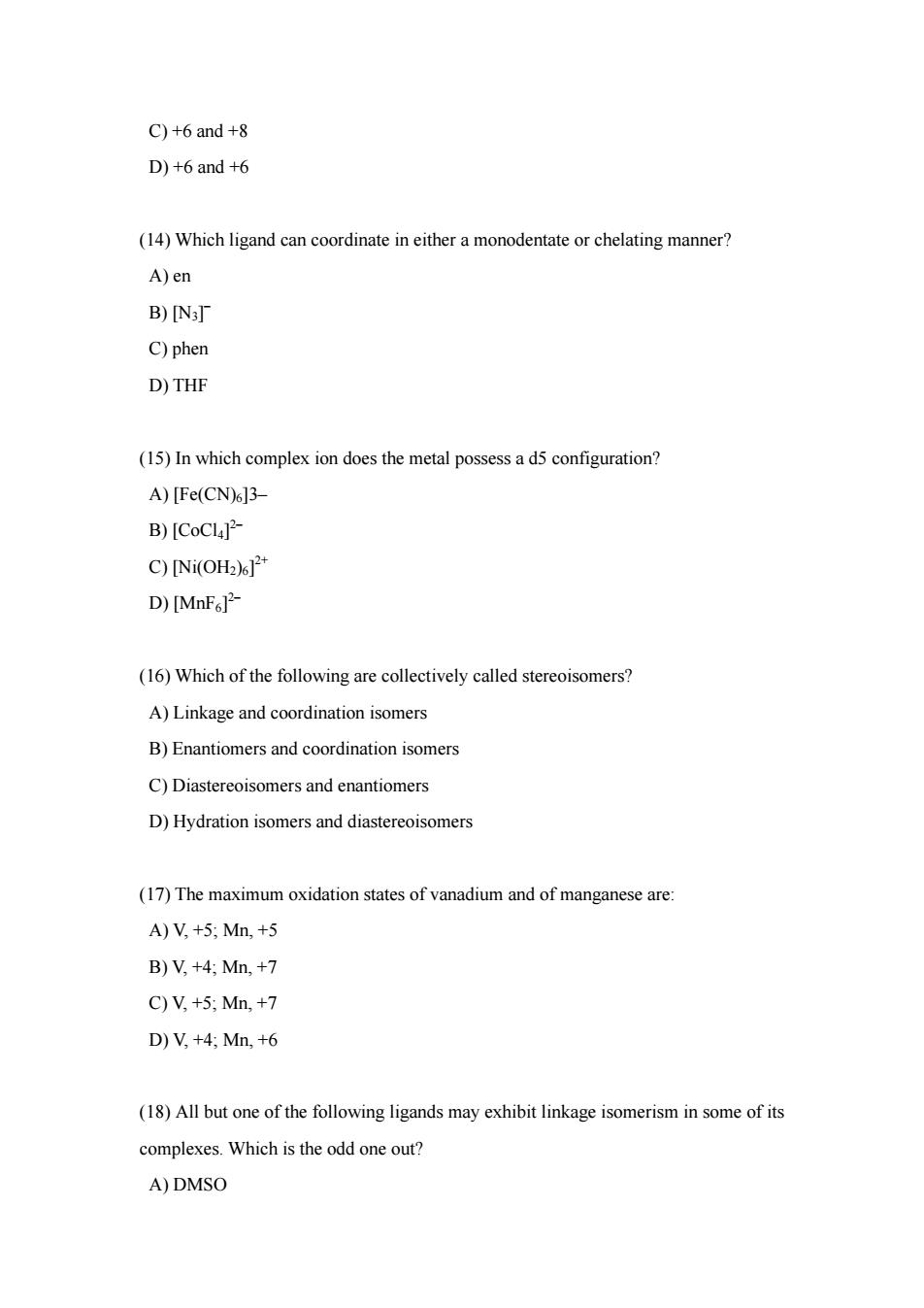
C)+6 and+8 D)+6and+6 (14)Which ligand can coordinate in either a monodentate or chelating manner? A)en B)[N3] C)phen D)THF (15)In which complex ion does the metal possess a d5 configuration? A)[Fe(CN)6]3- B)[CoCl]2- C)[Ni(OH2) D)[MnF6- (16)Which of the following are collectively called stereoisomers? A)Linkage and coordination isomers B)Enantiomers and coordination isomers C)Diastereoisomers and enantiomers D)Hydration isomers and diastereoisomers (17)The maximum oxidation states of vanadium and of manganese are A)V,+5:Mn,+5 B)V,+4:Mn,+7 C)V,+5:Mn,+7 D)V,+4:Mn,+6 (18)All but one of the following ligands may exhibit linkage isomerism in some of its complexes.Which is the odd one out? A)DMSO
C) +6 and +8 D) +6 and +6 (14) Which ligand can coordinate in either a monodentate or chelating manner? A) en B) [N3] – C) phen D) THF (15) In which complex ion does the metal possess a d5 configuration? A) [Fe(CN)6]3– B) [CoCl4] 2– C) [Ni(OH2)6] 2+ D) [MnF6] 2– (16) Which of the following are collectively called stereoisomers? A) Linkage and coordination isomers B) Enantiomers and coordination isomers C) Diastereoisomers and enantiomers D) Hydration isomers and diastereoisomers (17) The maximum oxidation states of vanadium and of manganese are: A) V, +5; Mn, +5 B) V, +4; Mn, +7 C) V, +5; Mn, +7 D) V, +4; Mn, +6 (18) All but one of the following ligands may exhibit linkage isomerism in some of its complexes. Which is the odd one out? A) DMSO 4
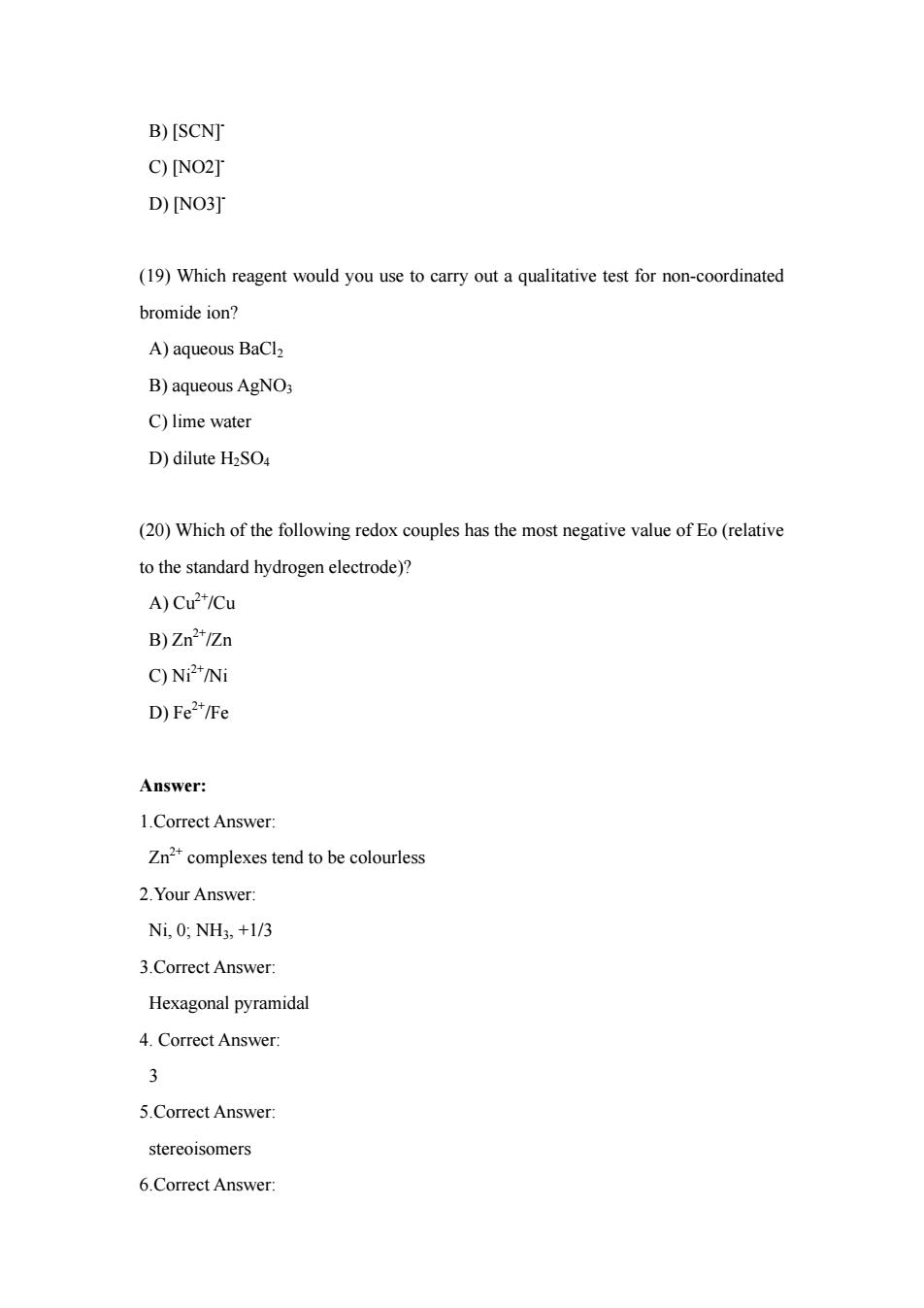
B)[SCNT C)[NO2T D)[NO3] (19)Which reagent would you use to carry out a qualitative test for non-coordinated bromide ion? A)aqueous BaCl2 B)aqueous AgNO3 C)lime water D)dilute H2SO (20)Which of the following redox couples has the most negative value of Eo (relative to the standard hydrogen electrode)? A)Cu2*/Cu B)Zn2+f亿n C)Ni2/Ni D)Fe2/Fe Answer: 1.Correct Answer: Zn2complexes tend to be colourless 2.Your Answer: Ni,0:NH,+1/3 3.Correct Answer Hexagonal pyramidal 4.Correct Answer 3 5.Correct Answer stereoisomers 6.Correct Answer:
B) [SCN]- C) [NO2]- D) [NO3]- (19) Which reagent would you use to carry out a qualitative test for non-coordinated bromide ion? A) aqueous BaCl2 B) aqueous AgNO3 C) lime water D) dilute H2SO4 (20) Which of the following redox couples has the most negative value of Eo (relative to the standard hydrogen electrode)? A) Cu2+/Cu B) Zn2+/Zn C) Ni2+/Ni D) Fe2+/Fe Answer: 1.Correct Answer: Zn2+ complexes tend to be colourless 2.Your Answer: Ni, 0; NH3, +1/3 3.Correct Answer: Hexagonal pyramidal 4. Correct Answer: 3 5.Correct Answer: stereoisomers 6.Correct Answer: 5

2 for [CrCl2(OH2)3 for [CoClz(en)2 7.Correct Answer: PPhs 8.Correct Answer In the 3P NMR spectrum,the observed J(PP)for trans-PtCl(PPh3 is greater than that for cis-[PtCl2(PPh3)2] 9.Correct Answer [acac]:monodentate 10.Your Answer: K[Cu(CN)2]:+2 11.Correct Answer: The energy difference between square-antiprismatic and dodecahedral structures for [W(CN)sJ产is small 12.Correct Answer [ZrMes] 13.Correct Answer: +8 and+6 14.Correct Answer en 15.Correct Answer: Fe(CN6J户 16.Correct Answer: Diastereoisomers and enantiomers 17.Correct Answer: V,+5;Mn,+7 18.Your Answer [NO3] 19.Correct Answer: aqueous AgNO3 20.Correct Answer:
2 for [CrCl2(OH2)4] + ; 3 for [CoCl2(en)2] + 7.Correct Answer: PPh3 8.Correct Answer: In the 31P NMR spectrum, the observed J(31PP 31P) for trans-PtCl (PPh ) is greater than that for cis-[PtCl (PPh ) ] 2 3 2 2 3 2 9.Correct Answer: [acac]– ; monodentate 10.Your Answer: K[Cu(CN)2]; +2 11.Correct Answer: The energy difference between square-antiprismatic and dodecahedral structures for [W(CN)8] 3– is small 12.Correct Answer: [ZrMe6] 2– 13.Correct Answer: +8 and +6 14.Correct Answer: en 15.Correct Answer: [Fe(CN)6] 3– 16.Correct Answer: Diastereoisomers and enantiomers 17.Correct Answer: V, +5; Mn, +7 18.Your Answer: [NO3] - 19.Correct Answer: aqueous AgNO3 20.Correct Answer: 6
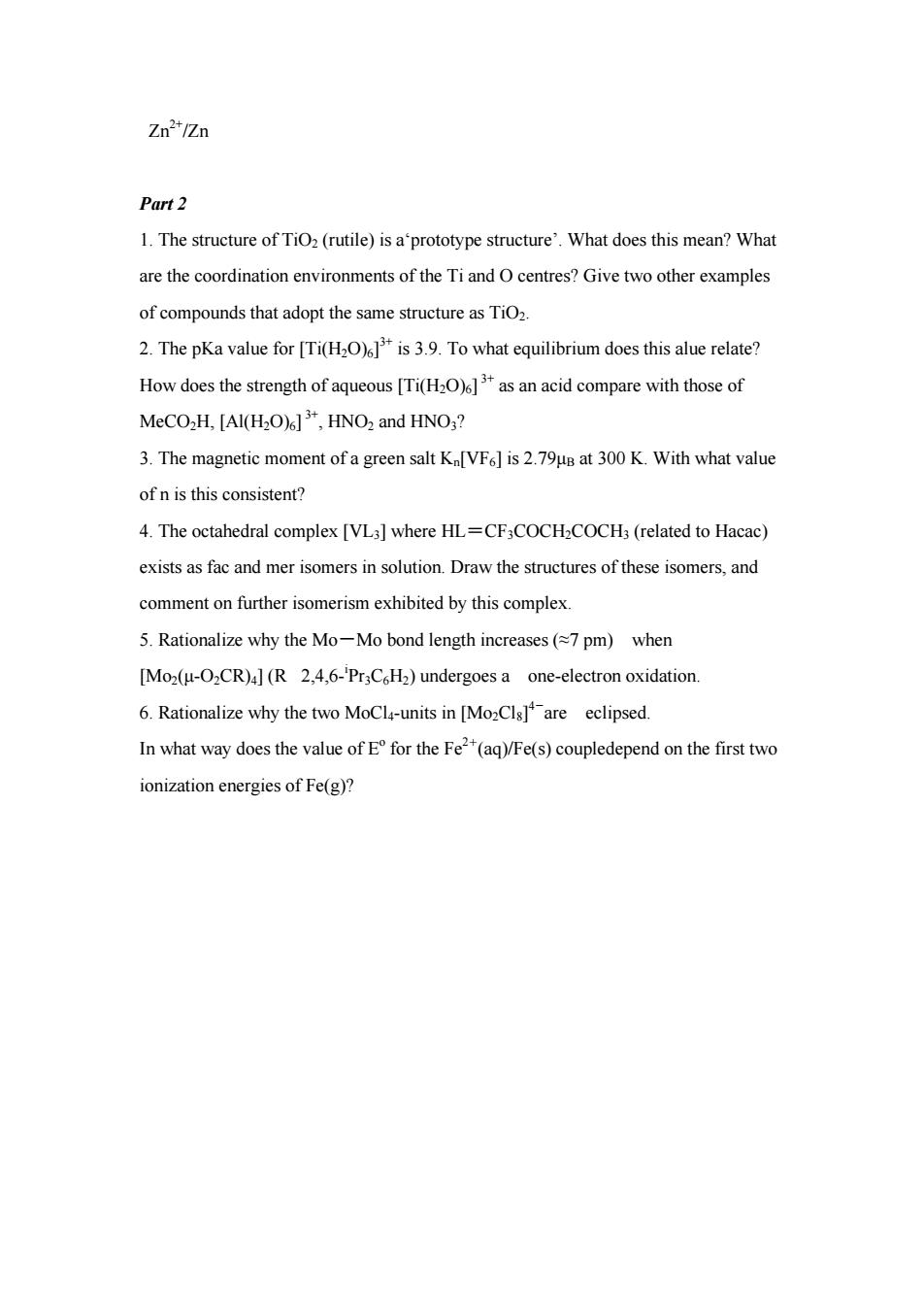
Zn2/Zn Part2 1.The structure of TiO(rutile)is a'prototype structure'.What does this mean?What are the coordination environments of the Ti and O centres?Give two other examples of compounds that adopt the same structure as TiO2. 2.The pKa value for [Ti(.9.To what equilibrium does this alue relate? How does the strength of aqueous [Ti(H2O]as an acid compare with those of MeCOzH.[Al(H2O)c].HNO2 and HNO:? 3.The magnetic moment of a green salt K[VF]is 2.79uB at 300 K.With what value of n is this consistent? 4.The octahedral complex [VLa]where HL=CFCOCH2COCH(related to Hacac) exists as fac and mer isomers in solution.Draw the structures of these isomers,and comment on further isomerism exhibited by this complex. 5.Rationalize why the Mo-Mo bond length increases(=7 pm)when [Moz(u-O2CR)](R 2,4,6-'Pr CH2)undergoes a one-electron oxidation 6.Rationalize why the two MoCl-units in [Mo2Cls]are eclipsed. In what way does the value of Efor the Fe(aq)/Fe(s)coupledepend on the first two ionization energies of Fe(g)?
Zn2+/Zn Part 2 1. The structure of TiO2 (rutile) is a‘prototype structure’. What does this mean? What are the coordination environments of the Ti and O centres? Give two other examples of compounds that adopt the same structure as TiO2. 2. The pKa value for [Ti(H2O)6] 3+ is 3.9. To what equilibrium does this alue relate? How does the strength of aqueous [Ti(H2O)6] 3+ as an acid compare with those of MeCO2H, [Al(H2O)6] 3+, HNO2 and HNO3? 3. The magnetic moment of a green salt Kn[VF6] is 2.79μB at 300 K. With what value of n is this consistent? 4. The octahedral complex [VL3] where HL=CF3COCH2COCH3 (related to Hacac) exists as fac and mer isomers in solution. Draw the structures of these isomers, and comment on further isomerism exhibited by this complex. 5. Rationalize why the Mo-Mo bond length increases (≈7 pm) when [Mo2(μ-O2CR)4] (R 2,4,6-i Pr3C6H2) undergoes a one-electron oxidation. 6. Rationalize why the two MoCl4-units in [Mo2Cl8] 4- are eclipsed. In what way does the value of Eo for the Fe2+ (aq)/Fe(s) coupledepend on the first two ionization energies of Fe(g)? 7